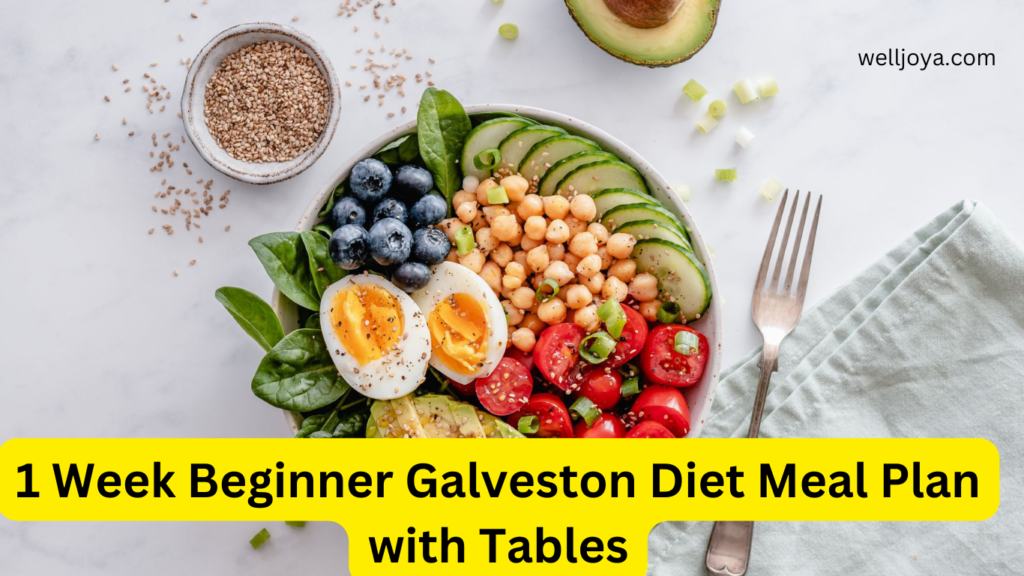1 Week Beginner Galveston Diet Meal Plan with Tables
The Galveston Diet is a nutrition plan designed specifically for women, focusing on reducing inflammation and balancing hormones. Developed by Dr. Mary Claire Haver, this diet combines intermittent fasting, anti-inflammatory foods, and low carbohydrate intake to help women, especially those going through menopause, manage their weight and improve their overall health.
What is the Galveston Diet?
The Galveston Diet originated from Dr. Haver’s personal experience and professional background as an OB/GYN. She aimed to create a diet that addresses common issues faced by middle-aged women, including weight gain, fatigue, and hormonal imbalances. The key principles of the Galveston Diet include:
- Intermittent fasting
Reducing sugar and processed foods
Emphasizing anti-inflammatory foods
Including healthy fats and lean proteins
Benefits of the Galveston Diet
Following the Galveston Diet can offer several benefits:
Weight Loss: Promotes a healthy metabolism and reduces fat storage.
Hormonal Balance: Helps regulate hormones, particularly in menopausal women.
Improved Energy Levels: Provides sustained energy throughout the day.
Reduced Inflammation: Decreases inflammation in the body, potentially reducing the risk of chronic diseases.
Diving Deeper into the Galveston Diet: Key Principles and Lifestyle Integration

The Galveston Diet is more than just a meal plan; it’s a comprehensive lifestyle change designed to foster better health and well-being, particularly for women navigating the complex changes of midlife. At its core, this diet emphasizes three key principles: intermittent fasting, anti-inflammatory nutrition, and low carbohydrate intake. These elements work synergistically to support weight management, hormonal balance, and overall health.
Intermittent fasting involves cycling between periods of eating and fasting. This method helps regulate insulin levels, promotes cellular repair, and can aid in weight loss by allowing the body to utilize fat stores for energy during fasting periods.
Typically, the Galveston Diet recommends a 16:8 fasting schedule, where you fast for 16 hours and eat during an 8-hour window. This approach not only simplifies meal planning but also aligns with the body’s natural rhythms, potentially leading to more sustainable weight loss and improved metabolic health.
Anti-inflammatory Nutrition
Anti-inflammatory nutrition is the second pillar of the Galveston Diet. Chronic inflammation is a significant contributor to many health issues, including heart disease, diabetes, and autoimmune disorders. The Galveston Diet combats this by prioritizing foods known to reduce inflammation, such as leafy greens, berries, fatty fish, nuts, and seeds.
These foods are rich in antioxidants, omega-3 fatty acids, and other nutrients that help reduce oxidative stress and inflammation. By focusing on these foods, the diet not only supports weight loss but also promotes overall health and longevity.
Low carbohydrate intake is the third fundamental aspect of the Galveston Diet. While carbohydrates are an essential part of any diet, excessive intake, particularly of refined carbs and sugars, can lead to weight gain, insulin resistance, and other metabolic issues.
The Galveston Diet encourages the consumption of complex carbohydrates like whole grains, legumes, and vegetables, which provide sustained energy and essential nutrients without spiking blood sugar levels. This balanced approach helps maintain steady energy levels, reduces cravings, and supports healthy weight management.
Integrating the Galveston Diet into your lifestyle involves more than just following a meal plan; it requires a holistic approach to well-being. This means incorporating regular physical activity, managing stress, and ensuring adequate sleep.
Exercise is a critical component, not only for weight management but also for maintaining muscle mass, enhancing mood, and improving cardiovascular health. Activities like walking, yoga, and strength training complement the dietary principles of the Galveston Diet, providing a well-rounded approach to health.
Stress Management is Another vital Aspect
Chronic stress can lead to hormonal imbalances, weight gain, and a host of other health issues. Techniques such as mindfulness meditation, deep breathing exercises, and spending time in nature can help mitigate stress and improve overall well-being. Adequate sleep is equally important, as it allows the body to repair and rejuvenate, supports cognitive function, and regulates hormones that influence hunger and metabolism.
By embracing the Galveston Diet and its principles, you are not just embarking on a weight loss journey but also committing to a healthier, more balanced lifestyle. This holistic approach can lead to lasting changes that not only improve your physical health but also enhance your mental and emotional well-being.
Practical Tips for Long-Term Success on the Galveston Diet
While starting the Galveston Diet can be an exciting step towards better health, sustaining these changes in the long term requires dedication and practical strategies. Here are some detailed tips to help you integrate the Galveston Diet into your daily life and maintain its benefits over time.
Meal planning and preparation
Meal planning and preparation are crucial for long-term success. Taking time each week to plan your meals can help ensure you have the necessary ingredients on hand and can prevent last-minute decisions that might lead to unhealthy choices. Consider preparing large batches of foods that can be used in multiple meals, such as grilled chicken, quinoa, or roasted vegetables. Investing in quality storage containers can make it easier to portion out meals and snacks for the week, making healthy eating more convenient.
Staying hydrated is another essential component. Drinking adequate water throughout the day supports metabolism, aids in digestion, and helps maintain energy levels. Carrying a reusable water bottle and setting reminders to drink can help ensure you meet your hydration goals. Additionally, incorporating hydrating foods like cucumbers, oranges, and watermelons can contribute to your overall fluid intake.
Listening to your Body
Listening to your body is perhaps the most important tip for long-term success on the Galveston Diet. Everyone’s body responds differently to dietary changes, so it’s essential to pay attention to how you feel and adjust accordingly. If you’re hungry, eat a bit more; if you’re full, don’t force yourself to finish your plate. This intuitive approach can help prevent overeating and promote a healthier relationship with food.
Incorporating variety into your meals is also important to prevent boredom and ensure you’re getting a wide range of nutrients. Try experimenting with different recipes, cuisines, and cooking methods. For example, you might explore Mediterranean dishes rich in olive oil and fresh vegetables, or Asian-inspired meals with tofu, ginger, and garlic. Keeping your meals interesting can make it easier to stick to the diet and enjoy the process.
Finding a support system can also make a significant difference. Whether it’s a friend, family member, or online community, having someone to share your journey with can provide motivation, accountability, and a sense of camaraderie. Sharing recipes, tips, and experiences can make the process more enjoyable and less isolating.
Finally, educating yourself about the principles of the Galveston Diet and nutrition in general can empower you to make informed choices. Understanding why certain foods and practices are beneficial can provide deeper motivation and help you make decisions that align with your health goals.
1-Week Beginner Galveston Diet Meal Plan
This 1-week meal plan is designed to introduce you to the Galveston Diet. Each day’s plan includes breakfast, two snacks, lunch, and dinner.
Day 1: Kickstart Your Journey
| Meal | Description |
|---|---|
| Breakfast | Avocado and Egg Toast |
| Snack | Greek Yogurt with Berries |
| Lunch | Grilled Chicken Salad |
| Snack | Almonds |
| Dinner | Baked Salmon with Vegetables |
Day 2: Building Momentum
| Meal | Description |
|---|---|
| Breakfast | Chia Pudding |
| Snack | Carrot Sticks with Hummus |
| Lunch | Quinoa and Black Bean Bowl |
| Snack | Apple Slices with Peanut Butter |
| Dinner | Stir-fried Tofu with Broccoli |
Day 3: Staying Strong
| Meal | Description |
|---|---|
| Breakfast | Smoothie Bowl |
| Snack | Mixed Nuts |
| Lunch | Turkey Lettuce Wraps |
| Snack | Cottage Cheese with Pineapple |
| Dinner | Shrimp and Asparagus |
Day 4: Midweek Motivation
| Meal | Description |
|---|---|
| Breakfast | Oatmeal with Nuts and Seeds |
| Snack | Celery Sticks with Almond Butter |
| Lunch | Spinach and Feta Stuffed Peppers |
| Snack | Boiled Eggs |
| Dinner | Chicken and Vegetable Skewers |
—
Day 5: Fueling Your Energy
| Meal | Description |
|---|---|
| Breakfast | Greek Yogurt with Honey and Nuts |
| Snack | Bell Pepper Slices with Guacamole |
| Lunch | Tuna Salad |
| Snack | Dark Chocolate Squares |
| Dinner | Beef and Broccoli Stir-fry |
—
Day 6: Nearing the Finish Line
| Meal | Description |
|---|---|
| Breakfast | Smoothie with Spinach and Banana |
| Snack | Trail Mix |
| Lunch | Lentil Soup |
| Snack | Cherry Tomatoes with Cheese |
| Dinner | Grilled Pork Chops with Green Beans |
Day 7: Celebrating Success
| Meal | Description |
|---|---|
| Breakfast | Scrambled Eggs with Spinach |
| Snack | Pear Slices with Almond Butter |
| Lunch | Chicken Caesar Salad |
| Snack | Greek Yogurt with Nuts |
| Dinner | Baked Cod with Vegetables |
Shopping List for the Week
To follow this meal plan, you’ll need a variety of ingredients. Here’s a comprehensive shopping list:
Proteins:
– Chicken breast- Salmon fillets
– Tofu
– Shrimp
– Turkey
– Tuna
– Beef
– Pork chops
– Eggs
– Greek yogurt
– Cottage cheese
Vegetables:
– Avocado
– Spinach
– Broccoli
– Asparagus
– Bell peppers
– Carrots
– Celery
– Tomatoes
– Lettuce
– Green beans
– Peppers
Fruits:
– Berries (strawberries, blueberries)
– Apples
– Pineapple
– Pears
– Bananas
Dairy and Alternatives:
– Greek yogurt
– Cottage cheese
– Almond milk
Grains and Legumes:
– Quinoa
– Lentils
– Chia seeds
– Oatmeal
Snacks:
– Almonds
– Mixed nuts
– Dark chocolate squares
– Trail mix
Tips for Success on the Galveston Diet
1. Meal Prepping Advice: Prepare ingredients ahead of time to make meal assembly quicker during the week.
2. Staying Hydrated: Drink plenty of water throughout the day to stay hydrated and support your metabolism.
3. Listening to Your Body: Pay attention to hunger and fullness cues and adjust portion sizes as needed.
4. Importance of Exercise: Incorporate regular physical activity to enhance the benefits of the diet.
Conclusion
The Galveston Diet offers a structured yet flexible approach to improving your health and managing your weight. By following this 1-week beginner meal plan, you can kickstart your journey towards better health, balanced hormones, and increased energy. Stick with it, listen to your body, and enjoy the benefits of this nutritious and satisfying diet.
FAQs
1. What can I drink on the Galveston Diet?
You can drink water, herbal teas, and coffee in moderation. Avoid sugary drinks and limit alcohol consumption.
2. Can I have cheat days?
– While occasional indulgences are okay, try to stick to the diet principles as closely as possible for best results.
3. Is the Galveston Diet suitable for vegetarians?
Yes, vegetarians can follow the Galveston Diet by focusing on plant-based proteins like tofu, legumes, and quinoa.
4. How quickly can I see results?
– Results vary, but many people notice improvements in energy and well-being within the first few weeks.
5. Are there any side effects?
Some people may experience initial side effects like headaches or fatigue as their bodies adjust to the new diet. These usually subside after a few days.
Read More:

